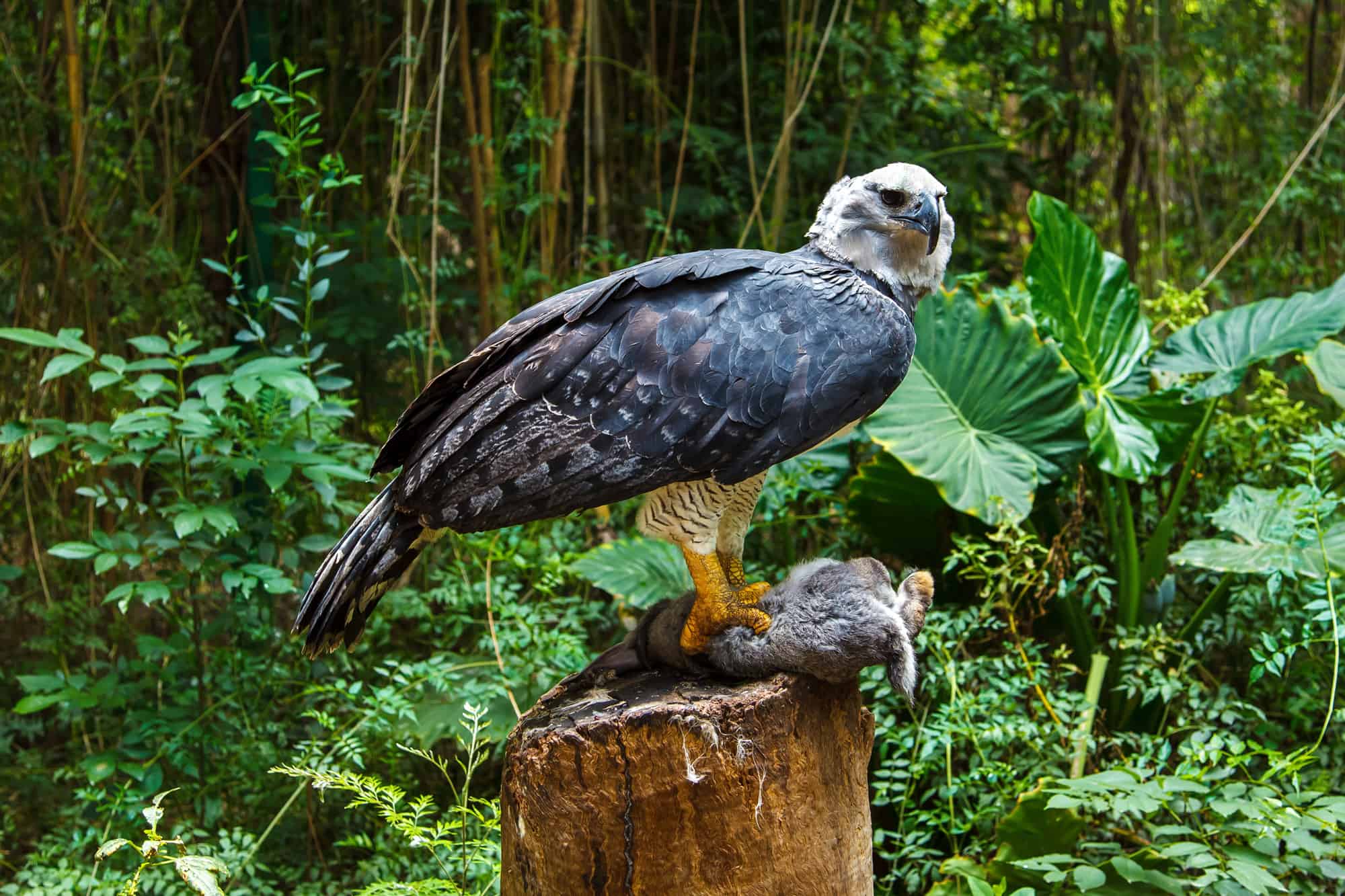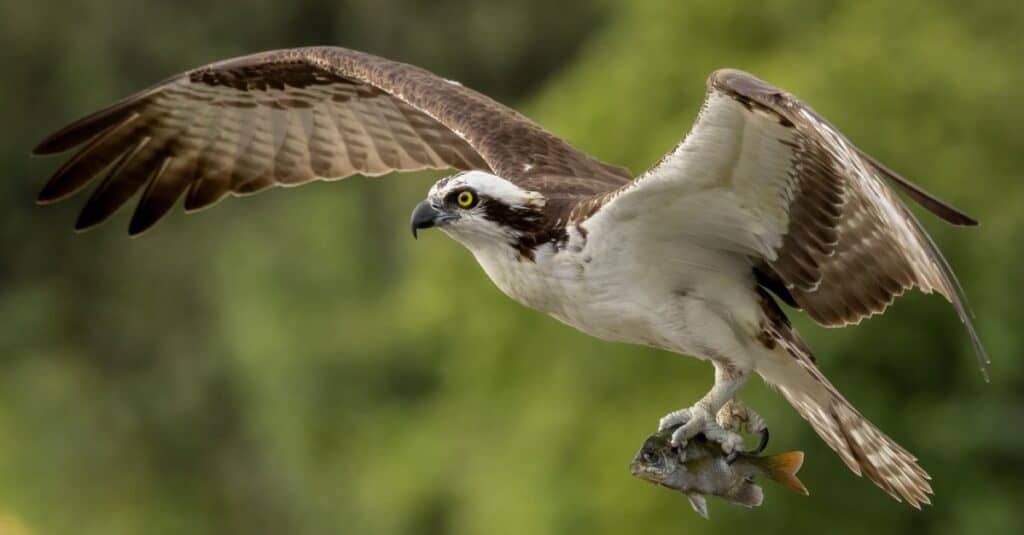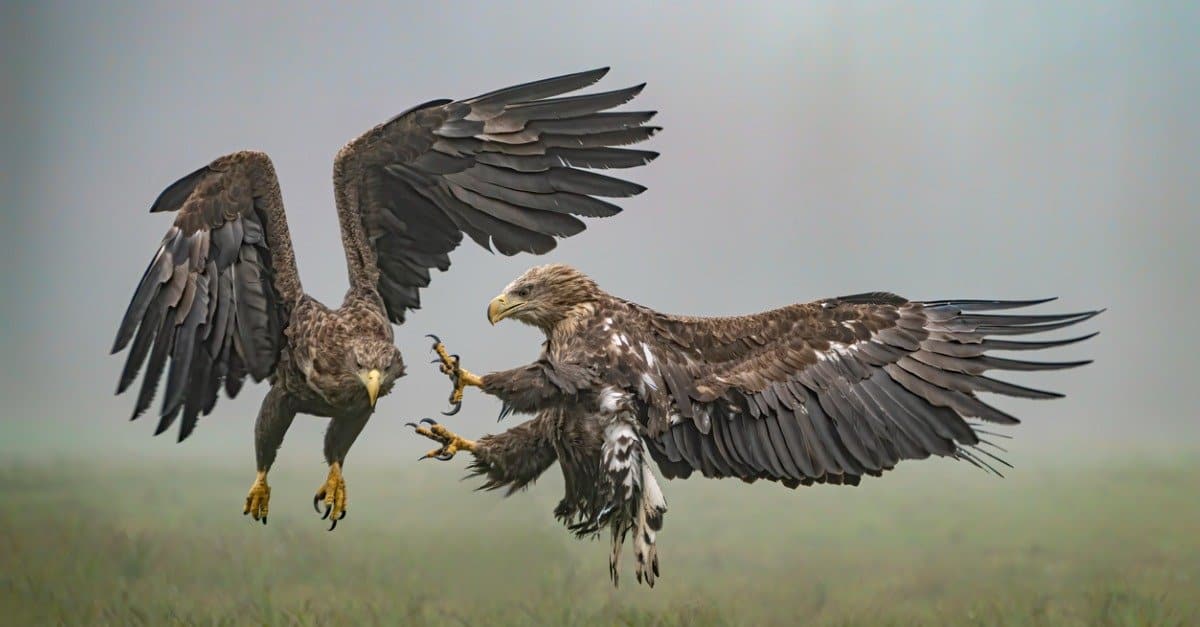Bird talons are incredibly sharp and beneficial for a variety of purposes. You might be surprised by why birds have razor-sharp feet and how they use them. For example, their sharp talons catch prey, climb trees, and defend against predators.
Talons are so sharp that they can cause serious injury to the bird itself. Anyone handling birds of prey, in particular, needs to be careful and aware of the injury risks.
Talons come in various shapes and sizes, depending on the bird. Plus, some bird talons are sharper than others! Keep reading to discover more about talons and their uses.
What are Bird Talons?

Bald eagles use their talons to catch fish.
©FloridaStock/Shutterstock.com
Birds have curved claws that stick out of the ends of their feet. Bird claws are also called talons. We use the term “talons” for birds of prey, but the claws of smaller birds are also technically talons.
The term “talons” also refers to very sharp bird claws. That’s why raptor claws are called talons, while a hummingbird‘s claws would be called, well…claws.
To explore the different features and uses of bird claws here, we’ll use the word talons for all sizes of birds because a small bird could have razor-sharp feet too!
Why Do Birds Have Razor-Sharp Feet?
Talons are an essential part of a bird’s anatomy, and they play a vital role in daily life. In addition, birds have talons to survive in nature.
A bird needs talons or claws in some of the same ways that humans need hands and feet. Though, bird talons also serve as weapons and tools.
How exactly do birds use their talons? Let’s discover all the fascinating ways birds use their talons every day.
The Many Uses of Bird Talons

The harpy eagle has massive talons for hunting sloths and other mammals.
©ChepeNicoli/Shutterstock.com
Birds use their talons for many different purposes, including hunting, perching, walking, climbing, preening (cleaning their feathers), and defending themselves. Their claws also help them grip onto their prey while carrying it through the air.
Talons help birds protect their food, nests, and hunting grounds from the competition. Raptors are fierce birds with massive talons, but their eggs are sometimes stolen for food by other animals. Intruders that threaten the home and offspring of a raptor are at high risk of deadly talon attacks.
Some birds, such as woodpeckers, use their claws to help them drill into tree bark to find food. Bird claws can also scratch the ground to catch worms and insects.
Birds also use their talons as eating utensils. For example, birds use feet and beaks together to crack open the shells of nuts and seeds to get to the food inside.
Bird talons are definitely multi-purpose appendages!
How Sharp are Bird Talons?
The bird’s diet determines bird talon sharpness and strength. Therefore, those that eat meat have sharper talons than those that eat mainly insects. Also, birds that eat mammals, like harpy eagles, have bigger, sharper talons than bald eagles that hunt primarily fish.
The talons of a bird of prey, such as an eagle, are much sharper than those of a songbird, such as a robin. This is because eagles need to be able to kill their prey quickly and efficiently. As a result, the talons of a bald eagle can exert at least 400 pounds of pressure per square inch (psi). That’s around ten times more pressure than the grip of a human hand!
What Are Bird Talons Made Of?
Bird talons have two main parts: the outer sheath and the bone underneath. The outer sheath is made of keratin and protects the inner bone.
Keratin is a protein that is strong yet flexible. It’s the same organic material in human fingernails. The keratin’s strength and flexibility make it possible for birds to grip onto prey and perch on thin branches without breaking their talons.
Did you know that a bird’s talons never stop growing? Like human fingernails and toenails, talons continue to grow throughout a bird’s life. Climbing, scratching, and everyday wear keep a wild bird’s claws from growing too long. However, birds in captivity need a little help keeping their talon length under control with regular trimming.
How Are Bird Talons Shaped?

Osprey talons are more curved than other raptor claws so they can catch and carry fish.
©iStock.com/Harry Collins
The shape of a bird’s talons can vary depending on how the talons are used. For example, owls have long, curved talons that are great for gripping onto prey. Their sharp talons help them to kill their prey quickly and efficiently. In contrast, woodpeckers have shorter and less curved talons to grip onto tree branches while they are pecking holes into the bark.
Osprey talons are much more curved than other raptor talons. Their talons also have tiny sharp spines (called spicules) underneath. This shape and texture help ospreys catch and hold on to the many fish they eat.
The size of their talons varies depending on the species of bird. For instance, bald eagles have huge talons that measure up to 4 inches long! These powerful talons help them catch and kill fish, their primary food source. However, hummingbirds have tiny talons that they use mainly for perching.
No matter the size or shape, all bird talons have one thing in common; they are usually sharp! The sharpness of a talon combined with the strength of the grip makes it difficult for prey (or the tiniest of seeds) to escape.
How Many Talons Do Birds Have?
Most birds have four talons on each foot. However, there are some differences in talon placement depending on the breed. For example, owls and eagles have three talons at the front and one at the back. However, the osprey has one reversible toe. The reversible toe moves to the front or the back of its foot.
So, the next time you see a bird, take a closer look at its feet. You might be surprised by the number and size of its talons!
What Birds Have the Biggest Talons?

Cranes have some of the biggest talons of any bird species.
©Ondrej Prosicky/Shutterstock.com
Some of the biggest talons in the bird world belong to the largest birds of prey, such as eagles, hawks, and owls. These raptors use their powerful claws to catch and kill their prey. Other birds with large talons include cranes and storks, which use them for wading through water and catching fish.
Interestingly, some of the smallest birds also have relatively large talons in proportion to their body size. These include hummingbirds and finches, which use their claws for perching and clinging to branches. Also, there is quite a bit of variation in talon size among different bird species.
Talon size is closely related to the bird’s diet and lifestyle. Birds of prey, for example, need large talons to help them grasp and kill their prey. A great example of a large bird with huge talons is the harpy eagle, one of the bird world’s greatest killing machines.
The size of a bird’s talons also varies depending on the size of the bird. Bigger birds have bigger talons, just like adult humans have bigger toes than their children do.
Here’s a list of birds with some of the biggest talons in the world:
- Andean Condor
- Cassowary
- Crane
- Giant Philippine Eagle
- Harpy Eagle
- Golden Eagle
- Bald Eagle
- White-tailed Eagle
- Steller’s Sea Eagle
- Martial Eagle
- Peregrine Falcon
- Red-tailed Hawk
- Lammergeier
- Ostrich
- Great Horned Owl
- Stork
- Black Vulture
- Cinereous Vulture
- Lappet-faced Vulture
- Turkey Vulture
What Birds Have the Smallest Talons?

Hummingbird talons are very small.
©ukrit.wa/Shutterstock.com
As you could guess, smaller birds typically have smaller talons. Yet, the size of even a small bird’s talons depends on how they live and what they eat.
One type of bird that has tiny talons is the hummingbird. Hummingbirds are known for their small size, and their talons reflect this. In addition, their little talons are very sharp and help them grip flowers and other objects.
Another type of bird with small talons is the finch. Finch talons are also quite sharp, but they are not as long or as thick as those of other birds. This helps the finch to grip onto smaller objects, such as the seeds they eat.
There are many other birds with small talons, including the wren, the warbler, and the sparrow. Each of these birds has unique features, but they all share one common trait; small talons.
Here is a list of birds with some of the smallest talons in the world:
- Hummingbird
- Cape Penduline Tit
- Esmeraldas Woodstar
- Finch
- Firecrest
- Goldcrest
- Pale-billed Flowerpecker
- Sparrow
- Warbler
- Weebill
- Wilson’s Storm Petrel
- Wren
Are Bird Talons Dangerous?
Talons are sharp, curved claws and are especially dangerous on birds of prey. They are used for hunting and defense and can inflict serious injuries. Birds with large talons, such as eagles and owls, can cause deep puncture wounds. Smaller birds can still scratch and peck fiercely, such as sparrows and finches.
Talon wounds can be very painful and may become infected. If you are scratched or bitten by a bird, wash the wound immediately with soap and water. Apply an antibiotic ointment to help prevent infection. Seek medical attention if the wound is deep or if you develop any signs of infection, such as redness, swelling, or pus.
Talons can also carry diseases, so it’s important not to handle birds with your bare hands. According to the Center for Disease Control (CDC), even pet birds can occasionally transmit diseases to their owners. Therefore, the CDC recommends always washing your hands after handling any bird.
How to Avoid Injury from Bird Talons
You can reduce your risk of being injured by a bird by avoiding contact with wild birds, especially those that look sick or injured. If you must handle a bird, wear gloves and other protective clothing. Never try to catch or restrain a wild bird with your bare hands.
If you have the opportunity or need to hold a bird of prey, you should always handle them with care. Make sure to grip their legs firmly but not too tightly, and support their body weight so that they feel secure. Keep their talons pointing down so that they can’t reach your skin. Never try to grab any bird by the wings, as this could injure them.
Talons: The Keys to Bird Survival

Birds have razor-sharp feet for a variety of important reasons.
©iStock.com/Dgwildlife
We hope we have helped you learn the main reasons why birds have talons on their feet. First and foremost, without their razor-sharp talons, birds wouldn’t survive in the wild. A bird would likely starve to death if it couldn’t hunt and forage for food with the aid of its talons. They wouldn’t be able to protect their nests and their young. Additionally, talons help birds balance while climbing, perching, and even flying. Finally, razor-sharp talons can also be used as a weapon for self-defense when they are under attack.
In conclusion, birds have razor-sharp feet for a variety of important reasons. All of these functions are vital for bird survival in their everyday lives.
Thank you for reading! Have some feedback for us? Contact the AZ Animals editorial team.








